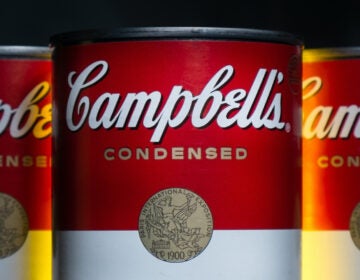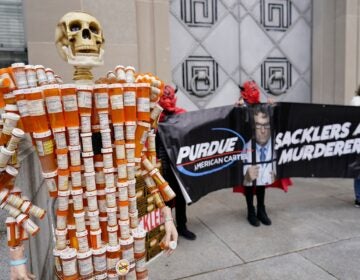Criminalization of pregnancy has already been happening to the poor and women of color
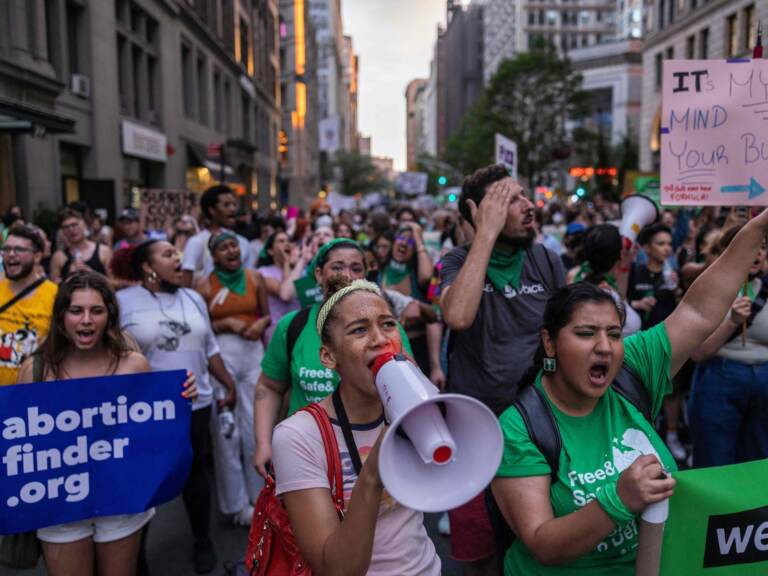
Abortion rights activists march from Washington Square Park to Bryant Park in protest of the overturning of Roe v. Wade by the U.S. Supreme Court, on June 24, 2022. (Alex Kent/AFP via Getty Images)
Haley McMahon says every time she hears someone say “you can’t ban abortions, only safe abortion,” she shakes her head a little.
McMahon studies abortion access and she says while women will certainly die because of the Supreme Court’s decision, this idea of women dying from back alley abortions is stuck in the past. “I understand why people go to that talking point,” she says. “But that’s just not where the evidence points.”
Medicine has advanced over the past fifty years. Now there are self-managed abortions — known as SMAs — pills people can take to safely terminate a pregnancy from home.
But America’s prison and policing system has also grown, McMahon says. Fifty years ago we didn’t have our current culture of mass incarceration.
“We’re gonna see more people being criminalized, more people being arrested and more people being incarcerated.”
“I think a lot of people’s first reaction was to pull out the coat hanger imagery,” McMahon says about the ending of Roe.
But a more accurate symbol might be prison bars.
The criminalization of pregnancy is already here
The patients were deemed suspicious, or they had not received good prenatal care, some had unexplained preterm labor, others a history of alcohol or drug abuse.
These were the pregnant women that the Medical University of South Carolina, in cooperation with police and the local prosecutor, drug tested without their knowledge in 1989.
“They set up a dragnet,” says Michelle Goodwin, a law professor at the University of California Irvine and the author of the book Policing The Womb. Over a period of five years, a total of 30 women were arrested for child abuse.
A few brushstroke details from the lawsuit that would follow: One woman spent the last three weeks of her pregnancy in jail, another was arrested moments after she had given birth, handcuffed while she was still bleeding, wearing only a hospital gown.
“Every one of the arrests were all Black women with the exception of one patient,” says Goodwin. “And on her medical chart, the nurse who was in charge wrote ‘lives with Negro boyfriend.'”
This was during the rapid growth of the war on drugs, which contributed to mass incarceration and reified racist myths like welfare queens and crack babies.
The shaming of Black women for supposedly creating a generation of crack babies seeped from public discourse into public policy, Goodwin says. It didn’t matter that the concept of the “crack baby” was a racist, fictionalized invention.
“Black women who suffered from stillbirths, Black women who had alerted their doctors that they suffered through addiction were being policed, were being stigmatized and ultimately were being arrested,” Goodwin says. “Whether they had healthy births or whether they had a miscarriage.”
The fact that Black women were targeted has nothing to do with their behavior, Goodwin says. “We have to dispel this notion that the type of policing that was taking place was a result of Black and brown women just being more criminal, more negligent, just simply bad mothers.”
“There’s absolutely no data that establishes that Black women were any different than white women in conduct during their pregnancy,” she says.
What was different was who was deemed suspect, often by medical staff. In the 80’s and 90’s, Goodwin says, “a Black woman was 10 times more likely to be reported to police and social services on matters related to her pregnancy than were white women.”
This kind of disproportionate targeting of women of color continues to this day, and stretches back far into the past.
“When we think about the history of policing the womb, policing reproduction, policing motherhood, it’s an experience that is not new,” says Goodwin.
Black women and Indigenous women have always been policed like this Goodwin says, which makes them “canaries in the coalmine.”
Like the women in North Carolina, whose arrests were harbingers for the criminalization of pregnancy that would increase even while abortion was legal, and for what will happen next, in the post-Roe world.
Policing pregnancy, she says, “is all about power and control.”
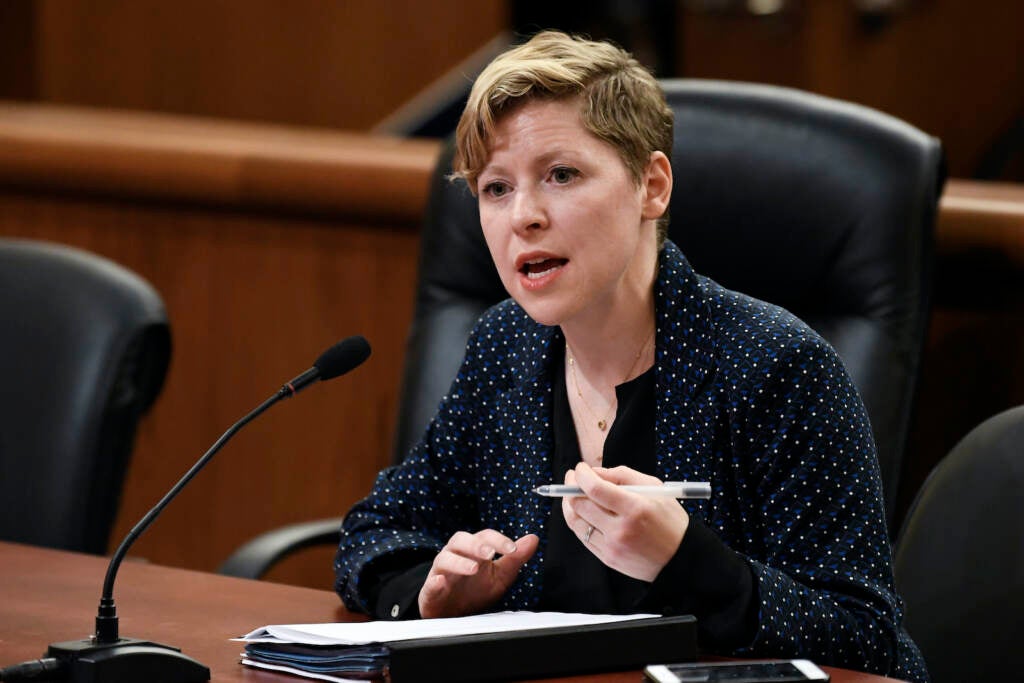
A new category of crime victim
If one of the major factors in criminalizing pregnancy was the war on drugs, the other was an ongoing wave of post-Roe feticide laws — which created a completely new class of crime victim, the fetus.
These laws often were passed under the auspices of protecting pregnant women, especially from domestic violence. There’s no arguing that people who are pregnant need protection. In the United States homicide is the leading cause of death among pregnant women. But the feticide laws didn’t work to make pregnant people safer, says Dana Sussman, acting executive director of National Advocates for Pregnant Women, known as NAPW. “What these laws are then used for is actually to criminalize the pregnant person herself,” says Sussman.
The laws that were supposed to protect women from violence, instead became another way to criminalize pregnancy.
“The first sort of experiment in this area,” Sussman says, “were primarily drug- using Black women who were charged with crimes in relationship to their fetus.” Those crimes were often things like child abuse or child neglect — but there were also cases where the rhetoric of the war on drugs cases merged into the feticide statutes to create a perfect storm of policing pregnancy.
Sussman says one case from 2006 in particular sticks with her.
When Rennie Gibbs gave birth a month early, her daughter was stillborn, her umbilical cord wrapped around her neck. She never took a breath. The cause of death seemed clear until the medical examiner found trace amounts of cocaine in the baby’s system; then it became murder — Mississippi’s “depraved heart” murder. The case was eventually dismissed in 2014.
Sussman says there was zero medical proof that Gibbs’ baby had died because the teenager had used drugs, but it didn’t matter. And it didn’t change the steady increase of prosecutions like that one.
“We are involved now in multiple cases in which the mother is blamed for the pregnancy loss and then criminalized for that loss,” Sussman says. “Without really any science or medicine backing it up.”
They are currently representing Brittney Pullow, a member of the Wichita Tribe, who was convicted of manslaughter last year for having a miscarriage when she was somewhere between 15 and 17 weeks pregnant. The state of Oklahoma faulted the miscarriage on methampetamine use, without scientific support.
In some cases, medical examiners use an ancient “lung float test” to determine if a baby is born alive, so they can make the case for murder. “Talk about antiquated,” Sussman says. “It’s like from the era of you’re a witch if you float, you’re dead if you sink — it’s the same stuff.” That test helped send another woman, Breyona Reddick, to prison for a decade just this year.
Not just drug use
In 2004, there was the Salt Lake City woman carrying twins who refused a c-section. When one died, she was charged with murder for that refusal. That charge was dropped, but she plead guilty to child endangerment for using drugs during her pregnancy. Many other cases involve no use of substances at all.
Like in Iowa in 2010, when a young woman fell down the stairs, losing her pregnancy. While being treated in the hospital, she confessed to a nurse that she hadn’t been sure she wanted a baby. She was accused of feticide, before the charges were dropped.
Then there was Bei Bei Shuai.
“Her boyfriend left her in the cold darkness,” says Michelle Goodwin. “One of the coldest days on record in the state of Indiana, I believe.”
“She was on her hands and knees, begging and pleading to him in a parking lot, not to leave.” After he drove off she swallowed rat poison. She was 33 weeks pregnant.
She survived the suicide attempt. The baby, who was delivered prematurely, died days later.
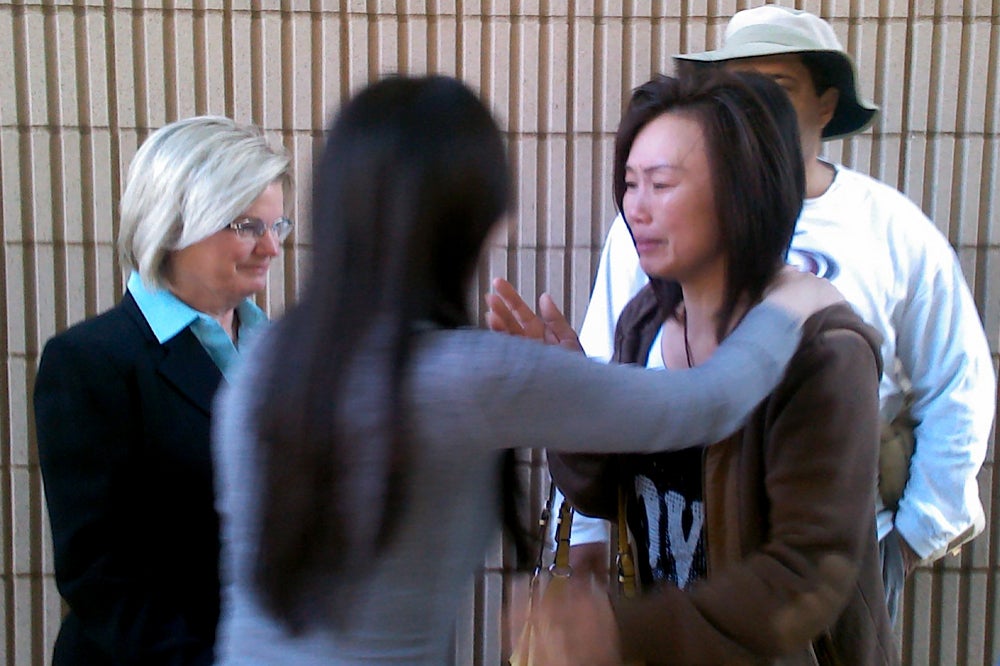
“Doctors said that they believed it was quite possible that the efforts that they made to save Bei Bei’s life may have contributed to the demise of the baby,” Goodwin says.
Shuai was charged with attempted feticide and murder, facing between 45 and 65 years in prison.
Suicide is not a crime, Sussman points out. “Often what we see is the conversion of otherwise legal behavior during pregnancy to criminal behavior, simply because the person is pregnant,” she says.
The same holds true for drug use, which on its own is also not a crime in most states. It is the person’s status as pregnant that changes that, that makes you vulnerable, Sussman says. “All of a sudden, the state can charge you with crimes that do not exist if you were not pregnant.”
NAPW has documented more than 1,700 cases in which a woman was charged, arrested, or detained for reasons related to pregnancy since 1973, when Roe was decided. Most of these cases, but not all, involve women who gave birth to healthy babies.
“If the protections of Roe and Casey no longer exist criminalization will increase across all pregnancy outcomes,” Sussman says. “This is not just an issue of abortion — this is an issue for anyone who is pregnant or who has the capacity for pregnancy.”
The growth of policing and mass incarceration
The last time that abortion was illegal, the landscape of American law enforcement was vastly different. The trend since then has been to increasingly push social problems onto the plate of policing. In most American cities funding for police departments takes up the majority of the budget, even as other public services lack funding.
“Our country in the past 50 years has decided that the police state is the way to respond to public health crises, to mental health crises, to poverty,” Sussman says.
“We have weaponized the state to get involved in so many aspects of our lives that were just not present in 1973,” she says about the year Roe made abortion legal. “The apparatus of mass incarceration and criminalization and the funding to support it did not exist in 1973.”
But it does now. And this matters for people whose pregnancies will increasingly become the direct purview of police. “All you need to show is that a woman exposed their child to some risk or perceived risk of harm or exposed their fetus to some perceived risk of harm,” she says, emphasizing that no harm needs to happen for the state to get involved.
“The exposure alone is considered a felony in multiple states already. And we anticipate we will see much more of this post-Dobbs.”
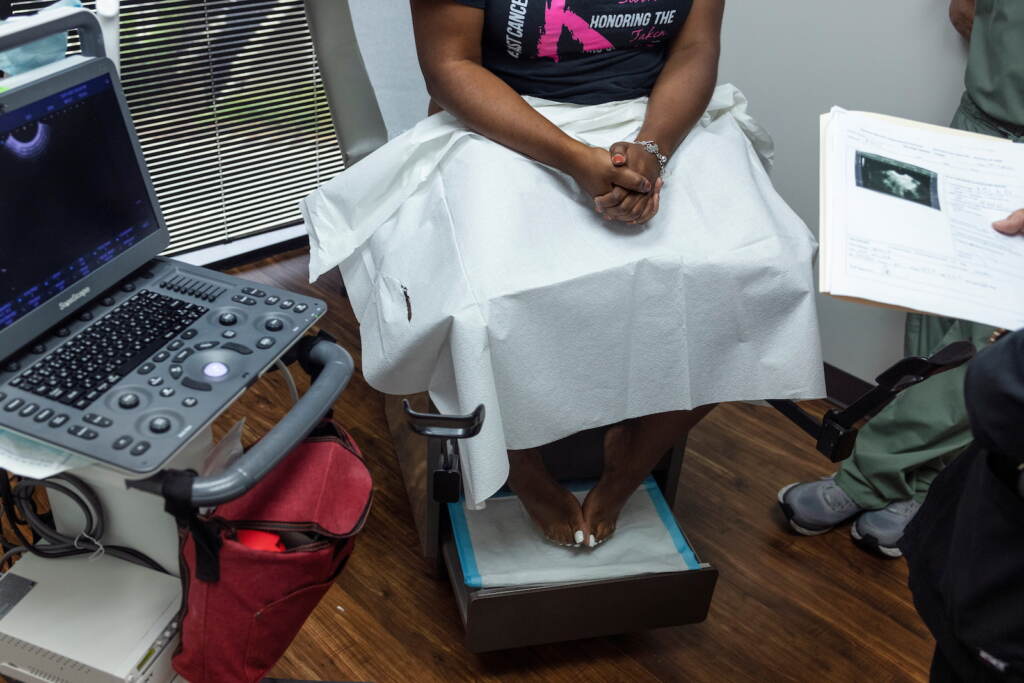
Sussman says that means miscarriages, which occur in 10 to 20 percent of pregnancies, could become heavily scrutinized.
“The vast majority of miscarriages have no known cause,” she says. “They’re often unexplained genetic abnormalities. There is nothing that the pregnant person could have done or not done to have changed that outcome.”
But there is virtually no way to tell the difference between a self-managed abortion and a miscarriage. For the most part, they look medically identical.
“There’s no examination,” says abortion researcher Haley McMahon. “There’s no blood test.”
“The only way they know is if you disclose that information,” she says.
Sussman says the door swings both ways. “I anticipate that prosecutors will sweep in anyone who is experiencing a pregnancy loss that they deem ‘suspicious,'” Sussman says.
Suspicious. That was the rationale used to target the women treated at the Medical University of South Carolina in 1989. Black women are twice as likely to have miscarriages as white and Latina women, making them statistically more vulnerable to suspicions that are based less on evidence, and more on racism and classism.
“It’s going to be poor people, people of color, young people,” says Sussman. “Anyone who is experiencing a mental health crisis, anyone who has a substance-use disorder, those are the people that are gonna be most vulnerable to suspicion and the specter of law enforcement when they experience a pregnancy loss.”
Which is why McMahon says it’s key to understand that the conversation about pregnancy and abortion is not just about health and physical survival, it’s increasingly about prison and policing.
Two years after nationwide protests over systemic racism in policing failed to produce a real reckoning, law enforcement is being handed even more power to surveil and punish pregnancy and women’s bodies.
“Who are the people who are going to enforce these abortion bans?” McMahon asks.
“We know exactly who they are, they’re the police.”
9(MDAzMzI1ODY3MDEyMzkzOTE3NjIxNDg3MQ001))


